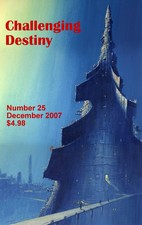


Reviews Home
Columns
Fiction by Title
Fiction by Author
Nonfiction
Movies by Title
Movies by Rating
Audio
Games
Contact, Carl Sagan, Pocket, 1985, 434 pp.
Contact is the only novel by the noted science writer and astronomer, Carl Sagan. It's not surprise that the book is about many of Sagan's key concerns: how science is done, how scientific findings can be communicated to non-scientists, the relationship between science and religion, the strange and interesting personalities of scientists, SETI (search for extra-terrestrial intelligence), and what a breakthrough discovery in SETI might be like. Contact can be a bit dry at times, due to the burden of all these themes, but it's also a decent read.
The plot itself is a bit slender. Eleanor Arroway (Ellie) is an astronomer who is obsessed with SETI. The first two chapters recapitulate Ellie's life for us, as a precocious child and then fighting her way through male-dominated scientific fields. Once she is in charge of her own SETI project, she finds a signal coming from the star system Vega (in a scene that is fairly dull -- this is definitely one scene that the movie does better). She sends out the information to scientific installations around the world, which attracts the ire of the American government. And she has to struggle to maintain a position of control, as many other people are trying to muscle in on the glory. There's a lot of political maneuvering and a great deal of scientific infighting. David Drumlin is the scientist who is most obsessed with pushing Ellie out, in inverse proportion to how loudly he mocked SETI before Ellie's discovery.
Experts are brought in from all over the world to decipher the signal from Vega. With some intense effort, they discover that the signal includes plans for a Machine of some kind. The American security apparatus remain convinced that the Machine is a threat, but Ellie and her colleagues think that it is a transportation device (and it looks like it will carry five people). A Machine is built at great cost, and later another one has to be built. I don't want to give away too much of the ending. Suffice it to say that the book is divided into three equal parts: The Message, The Machine, and The Galaxy.
Ellie Arroway is an interesting and sympathetic main character. She uses her brain, she falls in love, she fights against sexism in science. In this last regard, some of Sagan's writing got a bit awkward. I couldn't decide whether Arroway was a real character or a coat hanger for him to display his sensitivity to sexism in science. Her underdog status makes the audience identify with her, definitely, and at the same time, it came across as more than an audience-grabbing ploy. Sagan always points out this struggle, which is sometimes less interesting than setting it more in the future, where such a problem (hopefully) wouldn't exist. The other characters were all well-drawn. Sagan is generally strong at depicting intelligent people, just as he is sometimes not so strong in dramatizing their problems. Some plot business with Ellie's parents makes for a twist at the end, one that nicely balances the otherworldly triumph of Ellie's scientific side with some human developments and feelings. The other four scientists who go along in the Machine are described just enough to make us realize that they too have all the same dreams and aspirations and the same kind of personal history as Ellie. The religious opposition, as represented by Billy Jo Rankin, is given a nasty role, but is almost balanced by the character of Palmer Joss, a more moderate spiritual figure (Joss is the character that is most changed by the radically different emphases of the movie). We always know exactly where Sagan is coming from, but I must admit he did spend some work making his straw dummies seem like real people.
The climax of the book is a scientific discovery, appropriate enough for a writer with Sagan's bent. Working from a few hints from her voyage, Ellie decodes a mathematical message from the creator of the universe. So, now, not only has the book "shown" that there is indeed life out there somewhere, it also "shows" quite clearly that the divine that Ellie (and by extension, Sagan) could believe in actually exists. That is, a divine entity that has given a scientifically discoverable message, not one found in some moldy old book. This sounds a bit petty, but this type of fictional apologetics is sincere enough, if a bit pointed. It's pretty much what you could have expected before reading the book. What surprised me was his firm engagement with religion, and a few characters that were religious and still credible as human beings. Sagan follows his own beliefs quite closely, and constructs a fairly interesting read around his own premises. Read Contact with a bit of skepticism.
Also see the review of the movie based on this book.
First posted: January 19, 1998; Last modified: February 14, 2004
Copyright © 1998-2004 by James Schellenberg (james@jschellenberg.com)

Buy back issues of Challenging Destiny online from:
For the latest information on availability: Where Can You Buy Challenging Destiny?